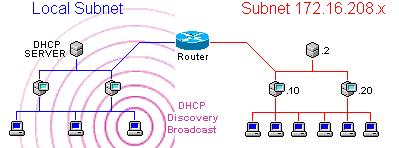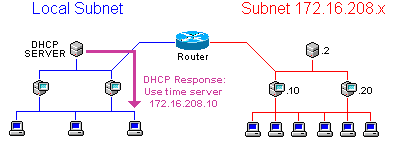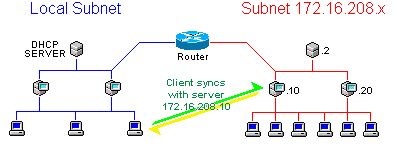This discussion applies to Domain Time II clients capable of automatic server discovery (Domain Time II Thin Client, Full Client, and domtimed daemons). The Domain Time II Thin Client always uses Automatic Configuration. The Full Client will only use DHCP discovery if the Automatic Configuration box is selected on the Time Sources tab page in its Control Panel Applet. The domtimed daemon will only use DHCP if both DHCP and AutoConfig mode are enabled in the domtimed.conf file. A Domain Time II Client in automatic mode will check for the presence of a DHCP server on your network. If a DHCP server is found, the DHCP options 042 and 004 (NTP servers and Time servers, respectively) are examined. Note: It is not necessary to set the TCP/IP protocol stack to get its IP address from a DHCP server in order for the Domain Time II Client to get a time server address. The Client uses its own independent inquiry of the DHCP server to discover the time server options. Therefore DHCP discovery of time servers can be used on a machine with either a fixed or DHCP-assigned IP address. An automatic Domain Time client with DHCP enabled will broadcast to locate a DHCP Server. Note that DHCP broadcasts usually do not cross routers.
 If DHCP options 004 or 042 are configured, the DHCP server will respond with the IP address of the time server.
 The client then uses the IP address provided by the DHCP server to contact and sync with the designated time server, even across a router.
 DHCP Options and Discovery Order These are the DHCP options that can be set to provide time server addresses, and the order in which clients use them to attempt to discover servers.
Domain Time Clients will examine Option 042 first. If any servers are listed, the Client will try to get the time from them using the Domain Time II protocol and, if that fails, the NTP/SNTP protocol. (The Thin Client and domtimed daemon only try the Domain Time II protocol.) If no Option 042 servers are configured, or if the listed servers do not respond, the Client next examines Option 004. If any servers are listed, Client will try to get the time from them using the Domain Time II protocol, and, if that fails, the TIME/ITP protocol. (The Thin Client and domtimed daemon only try the Domain Time II protocol.) If neither Option 042 nor Option 004 servers are configured, or if they all fail to respond, the Client will attempt to locate a Domain Time II server by broadcasting a discovery request on the local subnet. Automatic discovery therefore follows these steps:
Note particularly that if Options 042 or 004 point to servers that provide NTP/SNTP or TIME/ITP time services, the Domain Time II Client will use those servers first. If, for example, only Option 004 is configured, and it lists a server that provides only TIME/ITP, then when Domain Time II Client checks, it will fail when using the Domain Time II protocol, but succeed using the TIME/ITP protocol. Since the accuracy of the TIME/ITP protocol is approximately one second, the results will be less than optimal. We recommend not using Option 004 in DHCP unless the machines it lists are Domain Time II Servers. If Option 004 is already configured for some other purpose, then you may disable the use of DHCP by the Domain Time II Client, either by changing the UseDHCP registry setting to FALSE, or by changing the Use DHCP setting on the Options dialog in Domain Time II Manager. UseDHCP is one of the defaults you may specify in the INI Defaults (domtime.ini) file to take effect during installation of Windows Clients. It defaults to TRUE, meaning that the Client will use DHCP discovery. Note: Dial-up clients using Windows RAS won't be able to access the DHCP settings for Options 042 or 004 because RAS servers do not pass on DHCP requests from dial-up clients to the rest of the network. Enabling broadcasts on the RAS machine, having RAS use DHCP for its dial-up clients, or configuring DHCP relay, will only work for obtaining IP address leases. The DHCP relay mechanism on the RAS server filters the requests and responses and limits the information delivered to the client. In order for automatic configuration to work for dial-up clients, the RAS server must be running Domain Time II Server. |






